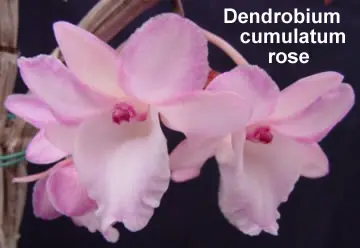 |
||
| Dendrobium There are over 1000 species in this genus reaching from India all the way down through to New Zealand. This also means that growing conditions are also diverse, from the cool growing Indian species that require winter rest to warmer species that require no winter rest. |
||
| Dendrobium cumulatum rose A pseudobulb epiphyte from Assam, Khasia Hills tropical valleys of Sikkim alt. 1000 m. Pale purple, lip white except the yellow base and sometimes a pink patch near the apex. This is a deciduous species which only flowers on leafless canes. Requires a dry rest after leaf fall which will encourage many flowers at the nodes along the stem. The old canes will continue to produce flowers over several years. |
||
| /\ Top of Page | ||
 |
||
| Dendrobium There are over 1000 species in this genus reaching from India all the way down through to New Zealand. This also means that growing conditions are also diverse, from the cool growing Indian species that require winter rest to warmer species that require no winter rest. |
||
| Dendrobium dawn maree This is a primary hybrid made in Hawaii in the early 1990s. A beautiful orchid with crystalline long-lasting white flowers and a sweet fragrance! Flowers are produced along the leaf stems generally in the autumn through spring months. Buds first appear as little bumps in the leaf axil. Flowers can last for two months or more! The flowers are white with varying amounts of yellow-orange in the lip. Keep plants on the cooler side(65-70), moist and bright, while they are in flower. The striking white and orange flowers are produced along the mature canes. Both parents belong to the Formosae Section of Dendrobiums therefore the younger canes and leaves are covered with interesting fuzzy black hairs. |
||
| /\ Top of Page | ||
 |
||
| Dendrobium There are over 1000 species in this genus reaching from India all the way down through to New Zealand. This also means that growing conditions are also diverse, from the cool growing Indian species that require winter rest to warmer species that require no winter rest. |
||
| Dendrobium dearei x cassiope | ||
| /\ Top of Page | ||
 |
||
| Dendrobium There are over 1000 species in this genus reaching from India all the way down through to New Zealand. This also means that growing conditions are also diverse, from the cool growing Indian species that require winter rest to warmer species that require no winter rest. |
||
| Dendrobium dearei Native of the Philippines and a member of the "FORMOSUM GROUP". These evergreen species can be grown as cattleyas; however the best flowering response results from exposure to winter night temperatures of 55 - 60 |
||
| /\ Top of Page | ||
 |
||
| Dendrobium There are over 1000 species in this genus reaching from India all the way down through to New Zealand. This also means that growing conditions are also diverse, from the cool growing Indian species that require winter rest to warmer species that require no winter rest. |
||
| Dendrobium densiflorum A widespread Asian species. An evergreen, epiphytic orchid, with 6 inch long lance-shaped or elliptic leaves. Long, drooping racemes, with nurmerous blossoms, appear from the upper nodes in spring. Grow epiphytically on a bark slab, or in slatted baskets with epiphytic orchid potting mix. A temperate-growing orchid, requiring humidity and partial shade from late-spring through summer, full light the remainder of the year. Keep dry in winter. Flowers best in small containers. |
||
| /\ Top of Page | ||
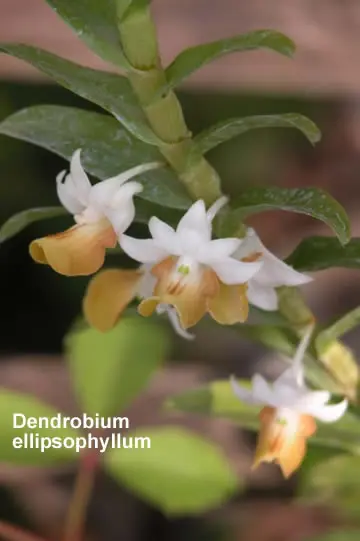 |
||
| Dendrobium There are over 1000 species in this genus reaching from India all the way down through to New Zealand. This also means that growing conditions are also diverse, from the cool growing Indian species that require winter rest to warmer species that require no winter rest. |
||
| Dendrobium ellipsophyllum SC. China, Indo-China, Borneo. These evergreen species can be grown as cattleyas; however the best flowering response results from exposure to winter night temperatures of 55 - 60 |
||
| /\ Top of Page | ||
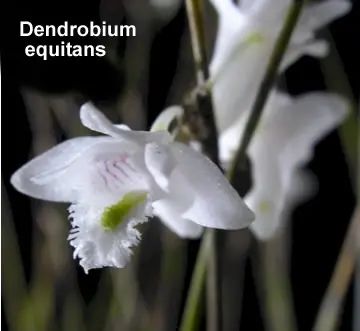 |
||
| Dendrobium There are over 1000 species in this genus reaching from India all the way down through to New Zealand. This also means that growing conditions are also diverse, from the cool growing Indian species that require winter rest to warmer species that require no winter rest. |
||
| Dendrobium equitans is endemic to the Philippines and Taiwan. The blooms are tiny, perhaps half an inch across, borne on grass like dead looking cane tips. Blooms last for only 1 week |
||
| /\ Top of Page | ||
 |
||
| Dendrobium There are over 1000 species in this genus reaching from India all the way down through to New Zealand. This also means that growing conditions are also diverse, from the cool growing Indian species that require winter rest to warmer species that require no winter rest. |
||
| Dendrobium farmeri A beautiful evergreen species which should not experience dormancy during the year. However, the plants should be moved to a cooler part of the house during the autumn, preferably with 50-55 |
||
| /\ Top of Page | ||
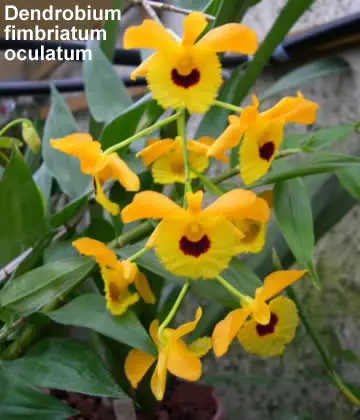 |
||
| Dendrobium There are over 1000 species in this genus reaching from India all the way down through to New Zealand. This also means that growing conditions are also diverse, from the cool growing Indian species that require winter rest to warmer species that require no winter rest. |
||
| Dendrobium fimbriatum var oculatum This name is a synonym for Dendrobium fimbriatum. Found from Himalaya to S. China and Pen. Malaysia. An evergreen, epiphytic orchid, with pointed leaves, 8-12cm long. In spring, drooping racemes (up to 20cm long) produce flowers from the upper nodes. Grow epiphytically on a bark slab, or in slatted baskets with epiphytic orchid potting mix. A temperate-growing orchid, requiring humidity and partial shade from late-spring through summer, full light the remainder of the year. Keep dry in winter. Flowers best in small containers. |
||
| /\ Top of Page | ||
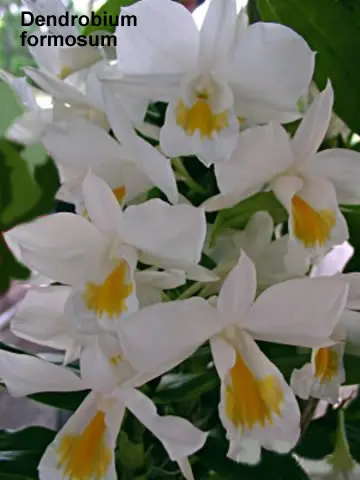 |
||
| Dendrobium There are over 1000 species in this genus reaching from India all the way down through to New Zealand. This also means that growing conditions are also diverse, from the cool growing Indian species that require winter rest to warmer species that require no winter rest. |
||
| Dendrobium formosum Native to C. Himalaya to Indo-China.An evergreen species however the best flowering response results from exposure to winter night temperatures of 55-60 F. (13-15 Celsius). Also, be cautious not to overwater just as new growth is completed. Perfect drainage is absolutely necessary. These species like copious amounts of water during new growth, but will not tolerate wet roots for extended periods. |
||
| /\ Top of Page | ||
 |
||
| Dendrobium There are over 1000 species in this genus reaching from India all the way down through to New Zealand. This also means that growing conditions are also diverse, from the cool growing Indian species that require winter rest to warmer species that require no winter rest. |
||
| Dendrobium friedercksianum Dendrobium friedricksianum is a stunning and rare species from IndoChina. It is a medium sized plant with long (40cm), club-like, canes with grooves and wrinkles on the silvery exterior. The plant is deciduous and requires a cool, dry, winter "rest". Blooming takes place in early summer when the plant is breaking dormancy and new growth begins. The flower buds appear on long stems in groups of 4 on a short inflorescence at each node of mature canes. The flowers are quite large and are a classic dendrobium shape, similar to Dendrobium nobile, but it is the yellow colour that makes this flower quite special. The sepals and petals are a pale yellow with a hint of cream. The substance is good, so the colour is deep and not semi-translucent as with some species. The flared lip has a darker shade of orange in the centre and the throat and this is punctuated by two dark maroon spots. |
||
| /\ Top of Page | ||
 |
||
| Dendrobium There are over 1000 species in this genus reaching from India all the way down through to New Zealand. This also means that growing conditions are also diverse, from the cool growing Indian species that require winter rest to warmer species that require no winter rest. |
||
| Dendrobium gracilicaule Native to S. Queensland to New South Wales. Known as the Tiger Orchid. This species is epilithic to epiphytic, favouring littoral rainforest, subtropical rainforest, warm temperate rainforest, dry rainforest, wet sclerophyll forests, dry sclerophyll forests, riparian (stream-side) areas, and rocky crevices and scree. Flowering occurs during winter and spring. Flowers are yellow-green, marked and suffused with red on the outside and are carried on an axillary (some apparently terminal) raceme. Foliage is alternate, clustered, apical, and the leaves are oval to ovate or lanceolate. |
||
| /\ Top of Page | ||
 |
||
| Dendrobium There are over 1000 species in this genus reaching from India all the way down through to New Zealand. This also means that growing conditions are also diverse, from the cool growing Indian species that require winter rest to warmer species that require no winter rest. |
||
| Dendrobium graminifolia Found in Lesser Antilles to Central & Southern tropical America. |
||
| /\ Top of Page | ||
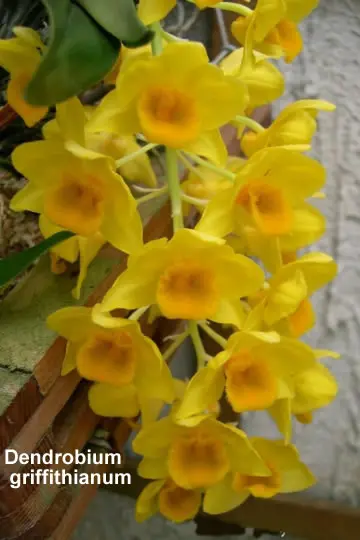 |
||
| Dendrobium There are over 1000 species in this genus reaching from India all the way down through to New Zealand. This also means that growing conditions are also diverse, from the cool growing Indian species that require winter rest to warmer species that require no winter rest. |
||
| Dendrobium griffithianum Assam to Thailand. These long, arching infloresences of soft gold flowers emerge from several spots on the same cane. Has fimbriated or hairy lip. Grows in intermediate temperature with moderate to bright light and likes a short winter rest. |
||
| /\ Top of Page | ||
 |
||
| Dendrobium There are over 1000 species in this genus reaching from India all the way down through to New Zealand. This also means that growing conditions are also diverse, from the cool growing Indian species that require winter rest to warmer species that require no winter rest. |
||
| Dendrobium guerreroi Native of the Philippines (Dinagat, Mindoro). |
||
| /\ Top of Page | ||
 |
||
| Dendrobium There are over 1000 species in this genus reaching from India all the way down through to New Zealand. This also means that growing conditions are also diverse, from the cool growing Indian species that require winter rest to warmer species that require no winter rest. |
||
| Dendrobium harveyanum A rare plant from Burma, Thailand and Vietnam. Fragrant yellow frilled flowers appearing in spring after a dry and cool winter rest, up to 10 flowers per spike. Rebloom from the same cane so do not remove the old canes. Water generously in late spring after blooming, summer and autumn, reduce water when the temperature is below 10 C and rest the plant in winter Cool - Intermediate, need complete winter rest, no watering until new canes are 5cm tall |
||
| /\ Top of Page | ||
 |
||
| Dendrobium There are over 1000 species in this genus reaching from India all the way down through to New Zealand. This also means that growing conditions are also diverse, from the cool growing Indian species that require winter rest to warmer species that require no winter rest. |
||
| Dendrobium hercoglossum S. China to Pen. Malaysia, Philippines (Mindanao)Small pink flowers with dark center hang from near deciduous canes. Grows in intermediate temperature with moderate to bright light. |
||
| /\ Top of Page | ||
 |
||
| Dendrobium There are over 1000 species in this genus reaching from India all the way down through to New Zealand. This also means that growing conditions are also diverse, from the cool growing Indian species that require winter rest to warmer species that require no winter rest. |
||
| Dendrobium johnsoniae New Guinea to Solomon Is. Large pure white flowers, beautifully marked with purple on the lip. Grows as an epiphyte in montane forests, often on Casuarina trees along watercourses or Araucaria trees and other situations where light levels are high. |
||
| /\ Top of Page | ||
 |
||
| Dendrobium There are over 1000 species in this genus reaching from India all the way down through to New Zealand. This also means that growing conditions are also diverse, from the cool growing Indian species that require winter rest to warmer species that require no winter rest. |
||
| Dendrobium kingianum Naturally occuring along the east coast of Australia Queensland and New South Wales. This plant lives exclusively on rock faces or among the decaying leaf litter in rock crevaces. Needless to say this is one tough plant. To get flowers a dry winter rest is essential. |
||
| /\ Top of Page | ||
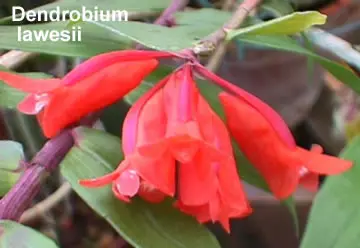 |
||
| Dendrobium There are over 1000 species in this genus reaching from India all the way down through to New Zealand. This also means that growing conditions are also diverse, from the cool growing Indian species that require winter rest to warmer species that require no winter rest. |
||
| Dendrobium lawesii one of the easiest New Guinea orchid species to cultivate it comes in a wide range of colours. Plants are small strongly pendant canes with beautiful bright-green deciduous foliage. The canes can produce blooms for up to 10 years, producing clusters of long-lasting 4cm tubular flowers rangeing in color from brilliant red to vivid purple. Can bloom several times per year. Best grown in small baskets or pots in a moisture-retentive media under filtered light. Prefers cool intermediate temperatures |
||
| /\ Top of Page | ||